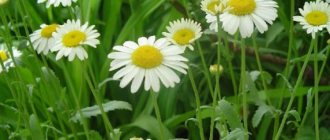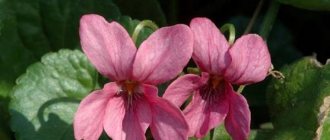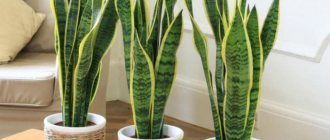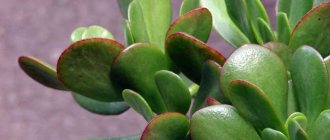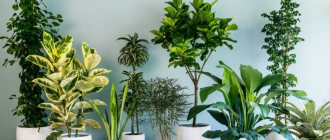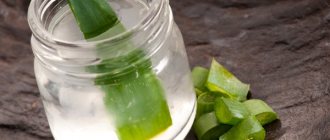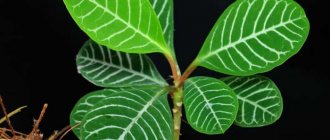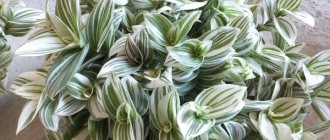FacebookTwitterPinterestEmailWhatsAppVKontakte
Aloe vera is a succulent plant that includes a large number of vitamins (A, group B, C, E), minerals (iron, potassium, calcium, magnesium), organic acids (succinic, citric, etc.). Everyone knows exactly what it looks like, what it tastes and smells like. Such a plant rarely blooms and survives the long absence of the owners of the house, because it has a good smell of moisture for several years to come.
Moreover, aloe juice is useful for both external and internal use. However, along with this, it has a number of contraindications and can cause harm to the body if used incorrectly. That is why it is so important to carefully study its properties and know its “composition”. For example, enzymes help break down sugar and fats, and the hormones auxins and gibberellins promote rapid wound healing and have an anti-inflammatory effect.
The list of benefits of using and using aloe does not end there. Here are its main studied properties:
- Has a general strengthening effect, improves immunity;
- Normalizes digestion;
- Eliminates diarrhea and constipation;
- Rejuvenates the skin, relieves tightness;
- Heals wounds, relieves pain from burns, moisturizes and disinfects the skin;
- Improves vision;
- Treats headaches;
- Copes with colds.
Aloe juice is successfully used to prepare immunostimulating agents, as well as as part of drugs against cancer. Many people use it in folk medicine, without the recommendation of doctors, as they consider it safe and universal.
Along with this, the plant also has harmful components that can cause side effects and allergic reactions, which will be discussed below.
How to make juice at home
It is worth noting that the juice obtained from the cold-aged plant is much healthier and has a higher concentration of useful substances than aloe juice without pre-cooling. For this reason, it is better to adhere to the well-known juice preparation technology:
- Cut off the lower “leaves” of the aloe and put them in a dark, cool place.
- Rinse.
- Grind in a blender or with a knife;
- Add cold boiled or distilled water to the resulting mixture in a ratio of 1:3, mix and place in the refrigerator again for 2-3 hours.
- Take out the container, transfer the “gruel” to cheesecloth or a sieve and strain thoroughly. Pour the juice into a glass container with a lid and place in the refrigerator.
Kinds
The term “aloe” usually includes both the tree-like agave bush and numerous rosette species of aloe vera, which produce their leaves almost from the soil:
- a plant with spotted sword-like leaves - aloe spinosa;
- variegated with white leaf edges - brindle;
- a plant with very wide white-green lanceolate leaves - rauhi;
- fan-shaped with a forked stem - folded;
- spiral-shaped with triangular leaves - multileaf;
- miniature, with a rosette less than 8 cm in diameter - jukunda.
In total, there are up to 500 species of aloe vera in nature. Many rosette plants in natural conditions reach a height of 5 meters, and tree-like plants can grow up to 10 m. On windowsills, the growth of the tallest plants does not exceed 80-100 cm. Indoor aloe plants can begin to bloom after they reach 10 years of age , although in nature some species produce flower stalks already in the second year of life.
How to make medicine from aloe vera with honey
Aloe with honey is a popular combination that is used in folk medicine for the prevention and treatment of diseases, and the elimination of cosmetic problems.
You can prepare various drinks, masks, mixtures, and infusions from aloe and honey.
The two components enhance each other’s healing properties, help fight bacteria, viruses, fungi, relieve inflammation, relieve pain, and stimulate cell and tissue regeneration.
Recipe number 1 (for cough)
Mix aloe juice and honey in a 1:1 ratio and take 1 tablespoon orally before meals 3 times a day.
Recipe number 2 (for gastrointestinal tract)
Grind aloe stems and combine with honey in a 2:1 ratio. Take one teaspoon 2 times a day with water. Course duration is 21 days.
aloe and honey
Recipe number 3 (general strengthening)
To boost immunity, chop 1 cup of walnuts, add 200 milliliters of aloe extract, 100 grams of honey, one teaspoon of lemon juice. Take one spoon before meals three times a day for two weeks.
Treatment with aloe juice
It’s worth saying right away that aloe juice should not be stored for future use, as it spoils very quickly. It must be stored in a closed glass container in the refrigerator for no more than 12 hours.
Aloe juice is a yellowish liquid, latex, which is a kind of plant protection from animals. It has a bitter taste and a large number of healing properties.
It is well used as a laxative that increases the amount of fluid in the body and stimulates mucus secretion.
Important! If you consume 20-30 ml of aloe juice daily, it will help reduce flatulence and relieve irritable bowel syndrome.
You can obtain juice using a juicer, or by chopping the stems and squeezing the liquid out of them by hand.
Houseplants that purify the air
Indoor plants are able to capture and neutralize harmful substances. An enclosed space constantly contains particles of harmful volatile substances:
- Formaldehyde irritates the mucous membranes of the eyes, nose and throat, causing skin itching, allergies, and asthma. Contained in carpets and furniture upholstery, tobacco smoke, and plastic dishes.
- Trichlorethylene is a carcinogen, affects the liver and kidneys, and causes irritation to the skin and mucous membranes. Contained in household chemicals and finishing materials.
- Benzene is a carcinogen, accumulates in adipose tissue, leading to the development of leukemia. Provokes shortness of breath and convulsions, lowers blood pressure. Found in cleaning and detergents, tobacco smoke, finishing materials, rubber products.
- Ammonia causes irritation and swelling of the airways, causing chest pain. Contained in electronics, tobacco smoke, and household chemicals.
- Xylene leads to irritation of the skin, mucous membranes of the eyes and nose. Used in the production of plastics, finishing materials, and glue. Contained in exhaust gases and tobacco smoke.
If you are looking for the best indoor plant for your home that purifies the air well, take a look at these types:
1. Chlorophytum comosum - a bushy plant with small white flowers actively fights formaldehyde, carbon monoxide, benzene and xylene.
2. Sansevieria trifasciata is a hardy and unpretentious plant. Neutralizes formaldehyde, benzene, trichlorethylene. At night, it absorbs carbon dioxide and releases oxygen.
3. Dracaena marginata removes xylene, trichlorethylene and formaldehyde from the air.
4. Anthurium andraeanum humidifies the air, converts toluene and xylene into harmless compounds.
5. Gerbera jamesonii neutralizes benzene, formaldehyde and trichlorethylene.
6. Moderate Aglaonema (Aglaonema modestum) effectively purifies the air from formaldehyde and benzene. Be careful - the juice and berries of the plant are poisonous.
7. Climbing ivy (Hedera helix) removes formaldehyde, trichlorethylene, carbon monoxide, benzene.
8. Nephrolepis exaltata humidifies and purifies the air from formaldehyde, xylenes and toluene.
9. Spathiphyllum 'Mauna Loa' effectively combats all types of harmful volatile organic compounds.
10. Garden chrysanthemum (Chrysanthemum morifolium) removes ammonia, formaldehyde, benzene, xylenes and trichlorethylene from the air.
11. Chamaedorea seifrizii purifies the air from substances such as benzene, trichlorethylene and formaldehyde.
Aloe for the face at home
Very often the plant is used for cosmetic purposes, as it has pronounced anti-inflammatory, regenerating, and rejuvenating properties.
Prepared masks and mixtures can be applied to any type of facial skin at any time of the year. Even dermatologists recommend using folk remedies containing aloe to treat burns, eliminate stretch marks, and acne.
Wrinkles
To reduce the number of small expression wrinkles, apply the crushed plant to the skin of the face for 10-15 minutes 2-3 times a week. Thanks to the content of 20 of the 22 amino acids necessary for human skin in aloe, the product will do an excellent job of moisturizing, nourishing, rejuvenating and softening.
Acne
For effective acne treatment, it is necessary to soak gauze or thin soft cloth with aloe juice and apply to the face for 40-60 minutes. After the procedure, you should not wash off the remaining juice from your face for another 2-3 hours. Enzymes will act on the upper layers of the epidermis throughout the entire time, clearing away pollution, preventing the development of microinfections and inflammation.
Mannose, which is part of the juice, has antibacterial properties, which also help reduce the number of rashes on problem skin.
Using aloe juice for hair
Any mask to which you add aloe juice is not recommended to be applied to the hair roots, but only distributed along the length.
If the composition contains any irritating “component”, then it is better to leave the mask on the hair until washed. If all ingredients are mild, they can be used on clean hair immediately after washing.
When making a hair mask, decide what result you want to see: achieve an antibacterial effect, improve the appearance or treat your hair.
Each one uses only juice (latex). Homemade, made independently, is more effective than pharmacy.
Recipe 1. For dry hair (damaged by a hair dryer or bio-perm)
Mix aloe juice with kefir, sour cream or cream, apply to hair and rinse after 10 minutes.
Recipe 2. Remove fat content
If you combine aloe juice with blue, green or black clay, cognac or lemon and leave the mask for 10-15 minutes, you can normalize the production of sebum on your head, while simultaneously “nourishing” it with useful microelements and amino acids.
Recipe 3. If you need to improve hair growth
An excellent stimulating mask of aloe and honey. For 2 teaspoons of honey, take 1 teaspoon of juice, mix and apply to hair. Leave the mask on for 30-40 minutes, wrapping your hair in a towel or a special “cap”.
The mask awakens hair follicles to growth and helps speed up the process of “growing” beautiful and healthy hair.
Kalanchoe
This flowering plant is also a succulent and is very common among home plant lovers. The popularity of Kalanchoe is due to its unpretentiousness to various conditions and a long flowering period.
Sergey Besarab identifies one of the substances that is found in Kalanchoe - bufadienolides. These same substances are found in the skin of poisonous toads. Chemical components can be harmful to a pet's heart.
JACLOU-DL / Pixabay
These substances can change the ionic balance inside the heart and impede the transport of potassium ions across the cell membrane in the myocardium. In small quantities, these substances are useful for some heart diseases and are even sold in pharmacies as part of medications. In large doses, these components disrupt the functioning of the heart and even lead to death.
The chemist cites the example that a third of livestock deaths in West Africa are due to cardiac glycoside poisoning from succulents. This most often occurs during the flowering period. If pets have the habit of eating plant leaves, then they risk receiving a lethal dose of a toxic substance.
In addition to Kalanchoe, the well-known fat plant, also known as money tree, contains a similar poison for animals.
Sancho85 / Wikipedia
Natural shampoo for hair growth
Homemade shampoo, which includes a component such as aloe, perfectly helps nourish dry and brittle hair, restores lightness, gives shine and a healthy appearance.
They can be used either in addition to regular shampoo or independently, every day.
Shampoo "Coconut"
Mix 100 ml of aloe juice and 50 ml of coconut oil, add the resulting mixture to your regular shampoo and use as directed. The lauric and miramistic acids included in the composition will help restore the protective properties of the scalp and “overcome” pathogenic microorganisms.
Nourishing shampoo for hair volume
Another way to give your hair a clean, healthy look and add volume at the roots is to make a natural shampoo with aloe and baking soda.
To do this, take 100 grams of dried crushed aloe leaves, mix with the same amount of water and add 4 tablespoons of baking soda. This option does not require mixing with regular shampoo and can be applied to hair without any additives or add-ons.
Aloe is an excellent dermatological remedy for skin diseases
Aloe has long been used as a bactericidal and bacteriostatic agent in the treatment of wounds, burns, ulcers, mastitis, abscesses, etc.
At the same time, the juice can be used superficially not only for serious injuries or cuts, but also for insect bites, lichen, psoriasis, and herpes.
To heal yourself at home and relieve itching and pain, it is enough to lubricate wounds and burns with aloe juice or make short-term lotions.
When treating and preventing psoriasis, it is necessary to add tincture of celandine and calamus root to the juice in equal proportions. Pour all this over 1 cup of boiling water and let it brew for 2-3 hours.
For severe burns, apply cotton wool or a bandage soaked in aloe juice to the wound, changing the bandage every 5-10 minutes for the first hour.
Aloe and Herpes: Treats or Relieves Itching
The home plant and its juice cope well with the herpes virus, helping to cleanse ulcers and purulent wounds, as well as produce antibodies.
To do this, apply a damp bandage to the affected area for 10-15 minutes every hour. During an exacerbation, it is necessary, in parallel with cosmetic treatment, to take aloe juice orally to strengthen the immune system - 1 teaspoon 3 times a day.
If there is no juice, you can apply crushed aloe, carefully spreading it on a gauze bandage or cotton wool.
The Best Houseplants for the Bedroom
The atmosphere in the bedroom should be soft and relaxing. Everything that surrounds you should calm you down and promote deep sleep, including indoor plants. You need to choose them with special attention, because some flowers can cause restless sleep and poor health. During sleep, we breathe rarely and deeply, so it is important that the air in the bedroom is clean and humid. Choose plants that can purify and disinfect the air, such as chlorophytum or begonia.
Usually little sunlight gets into the rest room, so preference should be given to shade-loving and unpretentious plants. When choosing landscaping for the bedroom, look for decorative foliage plants without bright flowers. The light soothing aroma will help you relax and fall asleep. For a restful sleep, you can place anthurium or spathiphyllum in the bedroom. Unpretentious geranium relieves headaches and repels flying insects.
Here are a few more plants that are great for the bedroom:
- Chlorophytum.
- Aloe.
- Spathiphyllum.
- Kalanchoe.
- Geranium.
- Begonia.
- Sansevieria.
- Myrtle.
- Jasmine.
- Lavender.
We’ll talk about which indoor plants you can’t keep in the bedroom below.
Aloe for the intestines and digestion
Aloe juice is a good laxative and therefore ideal for those who have intestinal problems, suffer from flatulence, constipation, and complain of irritable bowel syndrome.
For gastritis, you can safely dilute 1 tablespoon of home flower gel in a glass of water and take it no more than 2 times a day.
Along with this, do not forget that if you have gastritis, you should drink as much fluid as possible, not only aloe, but also plain water.
The plant has a beneficial effect on the gastrointestinal tract because:
- Accelerates the production of bile.
- Relieves inflammatory processes.
- Increases the secretion of digestive glands.
- Removes toxins.
- Renews blood.
Important! The high content of useful components (amino acids, enzymes, ascorbic acid, B vitamins, phenolic substances) helps in the treatment of intestinal and digestive diseases, improves the absorption of nutrients.
Chemical composition
The leaves contain many useful components (about 200), which determine the value of the crop:
- water (up to 97% of the mass);
- esters;
- traces of essential oils;
- acids: citric, cinnamic, malic, succinic, chrysophanic, l-coumaric, hyaluronic, isocitric, salicylic, etc.;
- tannins;
- resins;
- flavonoids, incl. catechins;
- beta-carotene;
- enzymes;
- bitterness;
- minerals: phosphorus, potassium, sodium, chlorine, calcium, iron, magnesium, manganese, chromium, zinc, cobalt, etc.;
- amino acids: threonine, methionine, leucine, lysine, valine, isoleucine, phenylalanine;
- simple sugars: fructose, glucose;
- polysaccharides, incl. acemannan;
- vitamins: B1, B2, B3, B6, B9, B12, C, E, retinol, choline;
- steroid molecules: sitosterol, composterol and luteol;
- anthraglycosides: nataloin, emodin, aloin, homonataloin, rabarberone;
- substances of the phenolic group, incl. anthraquinone.
Want to strengthen your immune system: choose aloe
Anyone who cares about their health strives to improve their immunity.
The enzymes contained in aloe juice help stimulate the immune system and completely destroy existing infections, viruses, and bacteria.
To prepare a powerful and effective remedy for strengthening the body, mix 30 grams of aloe leaves and 60 grams of lemon peel and chop. Add 3 tablespoons of honey, mix and leave in a cool place for 12 hours.
It is recommended to use 2-3 times a day before meals, 1 teaspoon.
Morphological description
The appearance of aloe is very diverse, from miniature ornamental plants to trees 8-10 meters high. All its species are characterized by sword-shaped leaves extending from the base-stem, along the edge of which there are rather sharp thorns. The color of the leaves ranges from pale light green to rich green. The roots are fibrous, located near the surface.
From the stem, once every 2-3 years, from January to April, a long peduncle with flowers from red to white, which are collected in a multi-flowered dense raceme, grows. The aloe flower has a strong smell that can cause headaches. The fruit is a cylindrical capsule.
Under artificial conditions, it reproduces with the help of pups or shoots, which quickly produce roots in water. In the natural environment it reproduces by both seeds and children. It is a light- and moisture-loving plant, not resistant to cold.
When is aloe effective: for diabetes or obesity
Due to the fact that the plant helps reduce cholesterol and blood sugar levels, it is excellent for weight loss and lowers blood glucose.
By regularly taking decoctions, infusions or aloe juice, you can gain health, increase immunity, get rid of excess weight and normalize the functioning of the nervous system.
Recipe
Cool the stems, chop them, pour vodka in a ratio of 1:5. After a month, the infusion can already be taken 1 teaspoon 2 times a day 15-20 minutes before meals.
What plants to place in the children's room
It is extremely important to create an optimal microclimate in the children's room. In the current environmental conditions, the presence of plants in a child’s room is mandatory. They collect dust, moisten, disinfect the air, and saturate it with oxygen. However, selecting plants for a nursery is not an easy task. There should be no poisonous, prickly or strong-smelling plants in the child’s room. Moreover, you should explain to the child that the plant is alive, and therefore requires care and attention.
Here are some good plant options for a children's room:
- Peperomia purifies and disinfects the air. A shade-loving plant with beautiful flowers resembling spikelets. Will forgive any oversights.
- Lemon tree has antimicrobial properties. Its leaves release essential oils, due to which the air in the room is filled with freshness and purity. The subtle citrus aroma does not interfere with sleep.
- Sansevieria is an unpretentious plant with beautiful leaves and small white flowers. Purifies the air from harmful volatile substances.
- Chlorophytum is a natural air filter. Absorbs all harmful substances and releases oxygen. An absolutely safe plant - both children and animals love to chew it.
- Violet is a plant with small bright flowers and leaves that are delicate to the touch. She is pleasant to watch and easy to care for.
- Fern relieves stress from an overabundance of information. Loves shade and frequent spraying.
- Tradescantia is a safe, low-maintenance ornamental plant. Some types of Tradescantia have interesting purple leaves.
- Begonia releases essential oils that purify the air in the room from dust and bacteria. Begonia leaves have slight, harmless pubescence.
Many houseplants are toxic. If handled correctly, they do not threaten an adult, but a child can easily touch or eat a beautiful flower. Poisonous plant sap can cause swelling of the larynx and irritation of the eyes and skin.
Do not place these plants in the children's room under any circumstances:
- monstera;
- dieffenbachia;
- alocasia;
- oleander;
- mandevilla;
- adenium;
- spurge;
- Akalifa.
How to prepare correctly
Aloe juice or crushed stems are stored in a cool, dark place for no more than 2 days. For this reason, it makes no sense to procure large quantities for future use. However, to make daily use easier, you can refrigerate the plant stems in advance and immediately chop them before use.
Before you are ready to break off the leaves, do not water the flower for 7 days. It is better to “remove” the stems themselves at the very bottom, where they are thicker and larger.
If you need dried “leaves,” cut them into pieces, place them on paper or a napkin, and leave them until completely dry. When the aloe takes on a wrinkled appearance, becomes brittle and fragile, it can be transferred to rag bags or paper packaging. Dried aloe stems can be stored for up to two years.
Recommended Dosages
In order not to harm your health or your skin, you should adhere to certain dosages and duration of the course of using the tincture, gel or juice.
- For gastrointestinal disorders, no more than 300 ml per day is permissible.
- For plaque or bleeding gums, add 1 teaspoon of gel or juice to the toothpaste.
- For burns, 100% aloe gel can be applied an unlimited number of times.
To reduce acne and improve the condition of facial skin, add 3 drops of aloe juice to a cotton pad soaked in lotion.
Possible side effects
When using any folk remedy or drug, allergic reactions and side effects may occur.
For example, consumption can cause individual intolerance to its components, heartburn, diarrhea, increased menstrual flow, and increased uterine tone.
Important! When aloe is used simultaneously with other medications, the active effect of the latter may decrease.
Not recommended for pregnant and lactating women.
Contraindications
When carrying out any procedures based on the use of aloe, you need to know what contraindications there are:
- pregnancy;
- internal bleeding;
- severe pathological disorders in the functioning of the kidneys, heart, liver;
- cystitis;
- allergy;
- haemorrhoids;
- hepatitis;
- malignant neoplasms.
It is not recommended to give aloe vera preparations to children under 14 years of age. In any case, a doctor's prescription is necessary.
Be healthy!
Some interesting facts
- Aloe is an amazing healing plant that can go without water for up to 7 years, since it can accumulate moisture and retain it in the stems for a long time.
- In the Middle East, they believe not only in the healing power of the plant, but also in the “otherworldly”, which helps protect the house and home from evil people and spirits. To do this, hang the dried stem above the front door.
- Agave juice can even be added to regular tea; it helps improve appetite, lift your mood, and strengthen your immune system.
- In the food industry, whole pieces of aloe are added to yoghurts, lemonades, and cocktails.
- If consumed incorrectly or in excess, pure juice can cause poisoning.
- This type of plant and its healing properties were discovered more than 4000 years ago.
- A very popular indoor flower that grows in almost every family.
- If you put the stem in water, air bubbles will form around it.
- The older the leaves, the thicker they are and the stiffer and rougher their spines. This is because older stems accumulate more moisture.
- There is an interesting belief that if flowers appear on an aloe, then the owner of the house will be happy for the same number of years as there are flowers on the plant.
Aloe is an amazing and healing flower that helps not only to improve the house, but also to cure during periods of illness, boost immunity, maintain health and give vitality. For its successful growth, it is enough just to plant it in a spacious bowl, put it in a bright place, and not water it too often.
Such care is the key to rapid growth and proliferation of the flower. It can be easily seated and given to your friends and relatives.
FacebookTwitterPinterestEmailWhatsAppVKontakte
Useful properties of indoor plants
Proper selection of indoor plants improves the microclimate in the house and the well-being of all its inhabitants. If you're still wondering whether to buy your first flower pot, here are some reasons for you.
Humidifier . During the heating season, the moisture level in the house drops to 20-30 percent, although 60 percent is considered the norm. Among the consequences of low humidity are dry mucous membranes of the nose and throat, flaking of the skin, the development of allergies, and respiratory diseases. Dry air is bad for wooden furniture and parquet floors. Growing indoor plants is one way to increase indoor humidity.
Plants that actively release moisture:
- Anthurium;
- Aglaonema (Aglaonema);
- Dieffenbachia;
- Maranta;
- Monstera;
- Nephrolepis;
- Philodendron;
- Hedera (Hedera algeriensis);
- Aechmea.
It should be noted that to increase air humidity to normal you will need several plants - at least 10.
Air filter . Phytofilter plants absorb harmful volatile substances and electromagnetic waves. The most unpretentious of these plants is chlorophytum - it traps harmful substances contained in furniture, plastic, and tobacco smoke. Plants belonging to the following genera reduce the amount of dust and microorganisms: Sansevieria, Tradescantia, Pelargonium, Begonia, Kalanchoë and Peperomia. It is believed that they are the best indoor plants for purifying the air.
Home doctor . Plants secrete biologically active substances (phytoncides) that suppress the growth and development of harmful microorganisms. They improve your mood, increase your performance, help you relax and fall asleep. Saintpaulia, myrtle (Mȳrtus) and conifers are known for their calming effects. Keep these in mind if you're looking for the best indoor plants for your bedroom.
Vegetable garden on the windowsill . Cultivating garden plants allows you to literally enjoy the fruits of your labor. Set up a mini-garden on the windowsill in your kitchen and fresh herbs will always be at hand.
